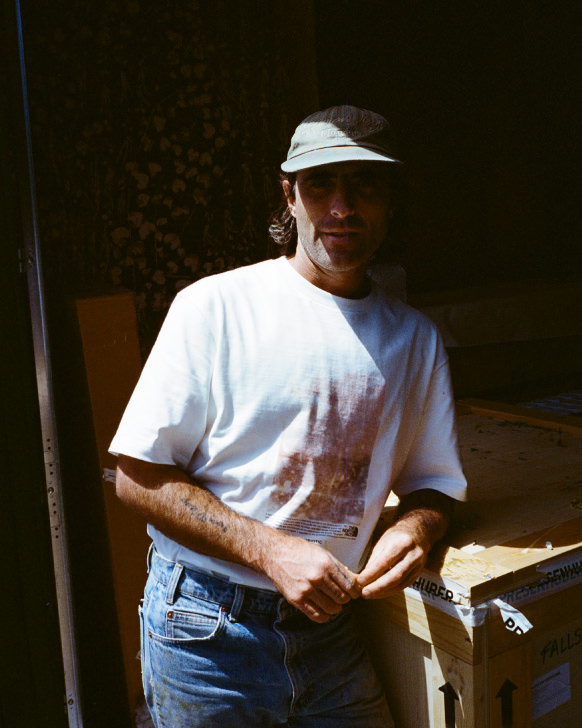About the Collaboration
Interview with SAM FALLS
簡単な自己紹介をお願いします。
Can you introduce yourself?
Sam
サム・フォールズ、ニューヨークとロサンゼルスを拠点に活動しているアーティストです。物理学、哲学、言語学、美術史を学び、写真を経て、今に至ります。現在はキャンバス、写真、陶器、彫刻など、さまざまな媒体を用いてコンセプチュアルな作品を制作しています。
My name is Sam Falls, and I am an artist based in New York and Los Angeles. I studied physics, philosophy, semiotics, art history, and photography. I specialize in making conceptual works on canvas, linen, photography, ceramics, and sculpture.
どのようにして現在のキャンバス作品の制作手法にたどり着きましたか?
Please tell us about your artwork process using canvas. How did you arrive at your current style?
Sam
大学で美術史を学んでいたとき、作品と鑑賞者との間の溝を埋めることに関心を持ち始めました。というのも、その頃のモダンアートやコンテンポラリーアートでは、鑑賞者やアート作品よりもアーティストに焦点が当てられているように感じていたのです。大学院では写真を専攻しましたが、写真だけを使ってアート作品を作るというのは私の行きたい方向とは少しずれていることに気づきました。どんな写真を撮ろうと、カメラレンズのフィルターを通り、紙にプリントされて額に飾られると、それは作品が生まれた場所と時間から切り離されたものではないかと。そこから、フィルムやデジタルカメラなど機械的なものは取り除き、写真の原理原則である「時間」と「光」を使った表現方法を探し始めました。こうして必然的に屋外で制作するようになったのです。
初期は、布を地面の上に放置し、その上にものを置いて、1、2年かけて太陽の光で色褪せさせる大規模な自然のフォトグラムを作っていました。それが現在の手法に辿り着くための大きな一歩でしたね。そのマテリアルは、鑑賞者が時間や空間を「体験」できる第一の情報源でしたから。この作品を制作すべく、ニューヨークからより日光の強いロサンゼルスに移住しました。ですが、冬場の突然の豪雨のとき、それに対処する他の方法を考えなければなりませんでした。それに、当時は抽象写真や多くのニューメディアの流れもあって、絵画を模範とするようなやり方を見つけようとしていました。そこで、プリントの工程や絵筆を使って描くように、雨で作用する染色顔料を使い始め、雨や大気中の水分で作品を完成させるという今の手法が生まれました。
When I was in college, my interest mainly focused on bridging the gap between artworks and viewers over time. From modern to contemporary art, the mediums began to increasingly revolve around artists instead of viewers and the artwork itself. I was undertaking photography in graduate school at the time, but I felt that using only photographs to create artwork slightly differed from the direction I wanted to take. Regardless of the image, it undergoes various filters of a camera lens and then gets printed on paper and framed. In other words, the image is detached from the moment of its creation in the place and the time it was made. So, I discontinued the use of mechanical mediums, such as film and digital cameras, and began using the philosophical precepts of photography: time and light. Both brought me outdoors.
I was making essentially large-scale natural photograms, which involves leaving fabric outdoors with an object on it that would fade under sunlight over one or two years. I found that it was a successful first step to where I am now because this material has become a primary source of information for viewers and enabled them to experience time and space. I moved to Los Angeles because the sunlight I needed was much more available than in New York. However, during sudden downpours in the winter, I began considering other ways to access that. In addition, abstract photography and various new media processes were emerging at the time. This prompted me to figure out a process for basically mimicking painting. I started working with pigments in the rain as an activating tool, which is similar to the printing process or painting using a paintbrush. Rain and moisture in the air became catalysts of the finished work.
作品作りはどのような場所で、どのようにスタートするのですか?
Where and how do you start a creation?
Sam
太陽と雨を用いるので、制作時間の約90%は外で過ごしています。国立公園や国有林に行くときは、興味のある自生植物や場所を探します。新しい土地ではいつも、その場所に同調するため多くの時間を費やすのです。もしくは、より個人的に重要なエリアであるハドソンバレーの自宅周辺で制作しています。ここではより長期間にわたって制作ができるので、新しく咲いた花を観察し、季節の移ろいを見ることができます。通常、植物が陽差しで萎れるのを避けるために夕方から作業し始め、雨や湿気が生じて染色顔料が作用する夜遅くまで取り組んでいます。
Working with the sun and rain, I spend 90% of my time outdoors. I travel to national parks and forests to find native plants and places that I am interested in. If I go to a new place, I spend a considerable amount of time getting in tune with the area. Alternatively, I work in the Hudson Valley around my house, a more personally significant area. I search for newly blooming plants that describe the season, as I can work longer here. I begin the process of making rain paintings in the evening to prevent the plants from wilting under the sun and then work on them deep into the night as rain and moisture arrive and activate the dyes.
今回、ザ・ノース・フェイスとのコラボレーションに選んだ作品「Spring Snow」(2023)の制作背景について教えていただけますか?
Can you tell me about the background of the artwork Spring Snow (2023), which we chose for our collaboration? How was it created?
Sam
ハドソンバレーにスタジオを構えてから、作品は一段と進化してきました。キャンバスを外に長時間置いておくと、花瓶に生けられた花のように、植物がキャンバスに染み込んだ水分を吸い上げていることが分かりました。その状態で植物はより長く生き生きと保たれ、雨や光にしばらくさらされた後に植物を取り除くと、このような幽玄なプリントを残すのです。春にこの作品に取り掛かり、その時季に最初に咲いた花を置き、夏から秋にかけてレイヤーを重ね、季節によって異なる天候を反映させました。この絵は、軽やかな色彩を放っており、季節が巡り、植物が咲き入れ替わりながら霧や雨、少量の雪に何度もさらされたことを表しています。
One part of the work was developed after we obtained this studio space in Hudson Valley. Leaving the plants outside longer, I realized that they were also absorbing the water that was saturated on the canvas, similar to flowers in a vase. In the state, they stayed alive longer, which enhanced the image by leaving a unique ghostly print when I removed them after they had been exposed to rain and light for a while. This artwork began in the spring which let me work with the first plants that bloomed. I worked over the summer and into the fall; I replaced layers and let the painting depict different weathers and seasons. So, the painting exudes the lightness of the color and reflects how the work was exposed to fog, rain, and small amounts of snow, as the seasons passed and the plants bloomed and replaced.
この名前は三島由紀夫の本のタイトル『春の雪』 (1965-1967) と重なります。本との関連性、そしてどのようにしてこの題名を選んだのかお伺いしたいです。
The name coincides with the title of Yukio Mishima’s book. How is the book related to the artwork and how did you select this title for your artwork?
Sam
その夏はほとんど三島由紀夫のオーディオブックを聴いていました。「Sprig Snow」と名前をつけたのは制作が完成してからで、春の降雪を使用したという技法的な点と、時間の過ぎゆく感覚を描いた本という二つの要素から、ぴったりだと思ったからです。加えて、私の作品における重要な要素は「メランコリー」であり、私の作品を最もよく表す言葉でしょう。それは悲しみでもダークなものでもありません。というよりも、時の経過を受け入れ、希望を感じる情緒的な表現で、いつも作品の中で取り扱いたいと思っていました。そこで、身体が太陽にさらされ、人生の経過とともに朽ちていくように、この作品を露光させました。成長と衰退、それらの組み合わせが根底にあるのです。
自然を扱うことは、もともと意図していたことではありませんでしたが、創作を続ければ続けるほど、自然との結びつきが深まり、自然をただ楽しむだけではなく、環境保護を意識するようになりました。子供を持つことや、子供の成長を眺めるほろ苦い気持ちなど、人生における多くのことにも通じます。私はその感覚と喜びを捉えたいのです。三島の『春の雪』におけるラブストーリーには、そのような心情が描かれていると思います。春の雪というのは、その季節の最後の雪であり、すぐに溶け、いつまでも残ることはありません。美しくも儚い。この本のタイトルにある二つの単語には多くのことが凝縮されています。
That summer, I mainly listened to audiobooks from the Yukio Mishima catalog. After finishing the piece, I named it Spring Snow which was perfect because it reflected both the technical aspect of working with precipitation in spring and the fact that the book also addresses the sense of time passing. In addition, I think an important element in my work is “melancholy,” which I think is the best word to describe it. It does not mean total sadness or darkness; instead, I find a hopefulness in this emotional content that deals with the passing of time. It is a state that I always wanted to address through my work. I intended my work to be a durational exposure and a depiction of the way our bodies are exposed to the sun and decay over the course of our lives. Growth and decay. For me, this combination is the heart of the matter.
It was not always my original intention to work with nature, but the more I did it, the more I bonded with nature and became not only a person who enjoys it but also an environmentalist. I think this process mimics many aspects of human life, from having children to the bittersweet feeling of watching them grow up. I am trying to capture this emotion as well as my excitement for them. I think the love story in Mishima’s Spring Snow (1965–1967) tries to describe this feeling. Spring snow is the last snow of the season, and it melts and dissipates quickly. It is beautiful but fleeting. The two words in the book title describe so much.
そもそもなぜ日本の文学に興味を持つようになったのですか?
Why is Japanese literature interesting to you?
Sam
もともとは松尾芭蕉の俳句、放浪者であり旅人である彼の人生に対するアプローチを通じて、日本の哲学や仏教に興味を持つようになりました。学生時代は、アメリカの詩、なかでも日本に長く滞在したことがあるサンフランシスコ出身のビート詩人、ゲーリー・スナイダーについて学び、そこから芭蕉を知りました。オレゴンのリード大学に行ったのは、スナイダーがかつて通っていたということに加えて、原子炉があったからでした。その経験は、科学と詩の融合のようなもので、対照的な二人である芭蕉と三島を想起させます。三島は政治や社会とのつながりを持っていたのに対し、芭蕉はそれらから逃れようとしていて、彼らは正反対の存在です。けれど、この2つの視点の間には、ある特別な文化を見出すことができます。科学と詩に対する私の考え方も同じで、そこに日本との結びつきを感じました。
I originally became interested in Japanese philosophy and Buddhism through the haikus of the poet Matsuo Bashō and his approach to life as a wanderer and traveler. At the same time, I was studying American poetry, specifically Gary Snyder, a beat poet from San Francisco who spent a long time in Japan, which is how I discovered Bashō. I went to Reed College in Oregon for undergraduate studies, because Snyder went there, and it has a nuclear reactor. So, this experience was a combination of science and poetry, which always reminded me of my views of Bashō and Mishima, who were relatively different. Mishima had connections in politics and society, while Bashō was essentially the opposite by escaping such connections. However, I see a particular culture in the middle of these dual perspectives. The same is true for my views about science and poetry, and I felt a nice corollary connection to Japan.
あなたの作品は人などのモチーフが植物やオブジェを使って描かれることもありますが、「Spring Snow」ではいかがですか?
Your works sometimes have motifs such as people using plants and objects. Is there any specific motif in Spring Snow?
Sam
この作品にモチーフはありません。たいていは、作品を作る場所の周囲の植物によって作品の大きさが決まります。森では高い木々が生えているので、その枝を使った大きな絵を制作することもあります。この作品では、いくつかの季節をまたいで制作することをあらかじめ想定していたので、小さなものを見失わず季節を捉えられるように十分な大きさにしたかったのです。こうした考えから、サイズとそれに合うような植物や花を選びました。
There is none in Spring Snow. Typically, the plants around the place I work dictate the size of the artwork. Forests have tall trees, so I can make bigger paintings using the branches. For this work, it was really this idea of knowing I would be working with it through a few seasons. So I wanted the size to be large enough to capture them without losing perspective of small objects. These ideas led me to decide on the size of the canvas as well as the plants and flowers that will be used, which seemingly fit well.
この作品は、薄い緑から暗い茶色まで、色に幅があるのが特徴的です。色に関してはどのように決めましたか?
This work shows a wide range of colors, from light green to dark brown. How did you decide on the colors?
Sam
色彩は私の作品において大切な要素です。特殊な染色顔料を使うことで、現在の手法に発展しましたからね。ひとつの作品でレイヤーごとに数色ずつ選びますが、最終的にはほとんどの作品に全色使います。屋外に置いておくと、水が染色顔料に触れてさまざまな動きを描き出します。そのときの大気に左右されるのです。雨がたくさん降ればより明るくパステル調になりますし、そうでなければ重たい色彩になる。単色で統一すると水の流れや花の配置などの表現が失われてしまうので、レイヤーの間に色のコントラストを持たせているのです。この絵の最初のレイヤーは春を捉えています。ハドソンバレーが緑葉であふれ、紫やピンクのアヤメ、赤いケシが混じっていたので、大量の緑を使いながら、それらの花の色を少量含めるようにしました。夏は暑さで植物が熟すため、よりコーラルや暖色系の色にシフト。秋になると朽ちていくので、黒や茶色を多用しました。
Color is an interesting aspect in my work because my work has evolved to a point where this specific pigment is used. For nearly every painting, I choose several colors for each layer and eventually use all colors. The reason is that water depicts so much movement to which the pigments are exposed if I leave it outside. It depends on the atmosphere of the moment. If there is heavy rain, then the color will be lighter and more pastel; if not, then the color will be heavier. It is about ensuring contrast between all colors, because if I was just using one color, it would lose a lot of the information about where the water was and how the flowers were placed. The first layer of this painting depicts springtime. The outdoors in Hudson Valley were green with splashes of the colors of flowers such as purple and pink irises and red poppies. I used smaller amounts but included these colors and large amounts of green. In the summer, as the weather became hotter and the plants matured, I shifted to using coral colors and warmer tones. In the fall, I used more black and brown hues, as the plants decayed.
サーフィンやバックカントリーのスノーボードなどが趣味だそうですね。アウトドアスポーツは、ライフスタイルや制作にどのように影響を与えていますか?
I heard that surfing and backcountry snowboarding are your hobbies. How do you think outdoor sports influence your lifestyle or your work?
Sam
野外とのつながりに大きな影響を与えています。アウトドアスポーツは私の人生の一部であり、それがあるから自然の中で過ごす時間を多く持てています。アートとは違えど、いつも自然のことを考えています。こうして家の中にいる今でも、外に出て、自然の中にいたいと思っているくらいです。とりわけサーフィンとスノーボードは、子供の頃から続けているスポーツ。作品づくりとは違う形で自然とコラボレーションができるとても美しい方法なのです。サーフィンをするときは、海のコンディションや波の形状を考えなければなりませんが、この天候に対する関心と関わりが私のアート作品の一部となりました。最近よくしているスプリットボードでも、雪の模様を見るのが好きです。登りはスローモーションで、そして下りは急加速する山での静かな体験に魅了されます。パドリングをして海に潜り、座って待っているのと同様に、どちらもとても瞑想的で、作品作りと似ています。その場所をよく観察し、自分の進むべき方向を把握する。時間をかけて進めていくことで、いい作品が生まれるのです。
They have influenced my connection to the outdoors. Playing outdoor sports is another component of my life that allows me to spend most of my time in nature. It is different from art, but I am always thinking about nature. Even now, as I am inside my house, I want to go outside and be with nature. Specifically, surfing and snowboarding are the major sports that I have been engaged in since childhood. It is a beautiful way to collaborate with nature in a different way. In surfing, I need to consider the condition of the ocean and the shape of the waves. This interest in and relationship with weather has become part of my artwork. Also, with splitboarding, which I have been doing a lot lately, I have become fixated on seeing snow patterns. The quiet experience of the mountain that is in slow motion on the way up then accelerates on the way down is beautiful. The same is true for paddling, as one goes under water, sitting and waiting. It is all very meditative, which is the same as my art process: I examine the area and it tells me the direction I should take. The process slows down for the work itself.
ザ・ノース・フェイスにまつわるパーソナルな思い出があれば教えてください。
If you have any of your personal memories of The North Face, can you share it with us?
Sam
幼少期はバーモント州で育ち、スノーボードを始める前はスキーが趣味でした。10歳の頃、友人の父親が北東部で最も高い山、カタディンへハイキングに連れて行ってくれたとき初めて、ザ・ノース・フェイスの素晴らしいアウトドアウェアを手に入れました。ダークブルーのシンプルなレインシェルに白いロゴが入り、防水性能を備えた一着でした。それを着てスキーやスノーボードをするたびに、クールだと感じていましたね。その体験は、服と機能性との関係について認識するきっかけにもなりました。現在、持っているギアの多くはザ・ノース・フェイスのものです。
I grew up in Vermont, and I was a big skier. My friend’s dad took us to hike Katahdin, the tallest mountain in the Northeast, which was the first time I bought a nice piece of outdoor clothing from The North Face. It was a simple rain shell in dark blue with a white logo and a waterproof performance layer. I always thought it was so cool in between spending much time outdoors skiing and snowboarding. This experience made me realize the relationship between clothing and function. Currently, a lot of my gear is from The North Face.
「探求をやめない」は、ザ・ノース・フェイスのスローガンですが、「探求」と聞いて何を思い浮かべますか?
“Never stop exploring” is the slogan at the heart of The North Face. What comes to mind when you hear the word “exploring”?
Sam
このスローガンは、人生のあるべき形を表しています。私は少しノマド的で、今でも西海岸と東海岸を行き来しています。もう15回は車で横断しました。こうした旅の一番いいところは、境界的なスペースと社会の外にいる時間を過ごせること。自然の中を散策したり、新しい街を歩いたりすることは、精神発達にとても大切です。子供たちにも新しいものを見せたいのです。新しい木の種類を知り、花が芽吹いているのを見るだけでも、とてもエキサイティングな冒険ですから。
The slogan is perfect for how life should be. I have always been slightly nomadic. Even now, I go back and forth between the West and East coasts. I have driven across the country 15 times. For me, the best part of these journeys is the intermediary spaces and time outside of society. Being on the road in nature or even walking in a new city is crucial for mental development. Right now, all I want to do with my kids is introduce them to new things because even just learning about a new type of tree and witnessing the sprouting of flowers are exciting adventures.
ザ・ノース・フェイスとスパイバー、ご自身とのコラボレーションの話があったとき、どのように感じましたか?
What was your first thought when you heard about this collaboration, you and The North Face and Spiber?
Sam
とてもうれしかったです。コラボレーションの依頼はあっても、アートから外れていると感じたり、商業的すぎると感じたりして、引き受けないことがほとんどですからね。けれど、今回のコラボレーションは、私が敬愛し、長年親しんできたザ・ノース・フェイスとのコラボレーションというだけでなく、スパイバーが持続可能性と地球環境に焦点を当てている点でも、とても興味を惹かれるものでした。
It was exciting to be part of a collaboration, which I do not typically undertake because it is often outside of art or feels very commercial. The thing that caught my eye was the fact that this collaboration was not only with The North Face, for which I hold personal admiration and long experience, but also Spiber, which is focused on sustainability and the environment.
クモや羊のような循環型タンパク質繊維を作り、それを環境に有害な素材に代わって衣服に使うというスパイバーのブリュードプロテイン™︎のアプローチについてどのようにお考えですか?
What do you say about the approach of Spiber’s Brewed Protein™︎ creating circular protein fibers such as spiders or sheep and using them to replace environmentally harmful materials in clothing?
Sam
持続可能性であるということだけでなく、新しい製品を開発するために用いられた技術と科学に感銘を受けました。ここから将来性のある他の製品が生まれていくという展望に、期待を掻き立てられます。地球への負荷を減らすと同時に、リユースやリサイクルを超えた別の道を切り拓いていくでしょう。
私は、自然界にすでにあるもの以上に美しいものや優れた構造を人間は作り出せないと考えてきました。スパイバーが目指すべきものとして動植物の科学、つまり環境にあらかじめ存在する構造を取り入れているのは、「必要なものはすべてすでに自然にあり、完璧である」という原則に従っているように思います。このプロジェクトに選んだ「Symbiotic(共生)」という言葉のように、自然、科学、技術との思慮深いコラボレーションですね。スパイバーは、自然にダメージを与えない方法のみならず、自然と手を取り合い、自然の力を借りてものを生み出していく方法を見出しています。
I was impressed with the technology and science applied to the development of products that are not only sustainable but also new. The prospect that other potential items could be produced as a result of this technology is thrilling because it could be a strategy for lowering our impact on earth as well as for creating a path that goes beyond simply reuse or recycle.
Early on, I have accepted that humans will never be able to make products more beautiful or better constructed than those in nature. The way that Spiber uses science in plants and animals as its guide and preexisting structures in the environment follows the principle that everything humans need has been existing and is perfect. Similar to the word that we chose for the project, “symbiotic,” it is a mindful collaboration between nature, science, and technology. Instead of finding ways to avoid inflicting damage to nature, Spiber is finding ways on how we can work with and through nature.
コラボレーションのデザインをする過程で、1つのアートピースを複数の製品にさまざまな方法で使用するという提案が興味深かったです。どのようにしてそのアイデアを思いついたのですか?また、完成したプロダクトで気に入っている点を教えてください。
In the design process of a collaboration between you and The North Face, we saw your interesting approach of using one art piece for multiple products in different ways. How did you come up with the idea? Also, please share what you like about the finished products.
Sam
さまざまな要素、色、そして季節を横断しているため、絵を部分的に切り取ってさまざまな製品に配し、コラボレーションとしてまとめると全体の作品になるという考えが浮かびました。また、私が書いた概要テキストをプリントするのは、ザ・ノース・フェイスのアイデアでしたね。書いたときはメディア向けに使ってもらえればと思っていましたが、作品と一緒に前面に出し、その素材と持続可能性の理念について考慮されていることがうれしかったです。通常は作品の裏に隠れているものなので、私にとって新鮮でした。単に作品というより、このコラボレーションの包括的なテーマが重要だったのです。
The work features various elements and colors that traverse seasons, so we could take sections of the painting and cut them to be distributed across products. It was your idea to print the text of my synopsis. When I wrote it, I hoped it would be used more for the press, but I was extremely happy to have it foregrounded with the work and to have this consideration for the philosophy, which are both materials that we are addressing and sustainability. It was refreshing for me because it is often backgrounded. Apart from the painting, the overarching theme of this collaboration was important.
「共生」という言葉は、よく作品について使う言葉ですね。あなたにとってのこの言葉の意味を教えていただけますか?
“Symbiotic” is a word used in the project, which you often use to describe your work. Can you tell us what the word means to you?
Sam
これまで長年、自然との共同作業における私のプロセスを表現するためにこの言葉を使ってきました。2つの有機体は協力し合うことで共存し、片方なしに存在することはできません。自然は私の芸術を創造するのに必要なものであり、また私の芸術が人々に自然の美しさだけでなく、その裏にある、私が自然保護に対して抱いている深い理念的な考えも喚起するものとなることを願っています。鑑賞者を自然に導き、そしてまた自然を屋内に取り込み、両者の間に生まれる共生的な空間を作れたらうれしいですね。
I have used the term many times over the years to describe my process of collaborating with nature. My understanding of it is that two organisms sustain each other through collaboration, such that one cannot exist without the other. Nature truly feeds what I do and is necessary to make art, and the art that I make hopefully creates not only awareness about the beauty of nature but also the deeper conceptual agenda I hold in relation to its preservation that is not commonly found on the front line of the work. I want to bring viewers outdoors and the outdoors inside and to create a symbiotic space between the two.
人間と地球の未来について、どのようにお考えですか?環境を改善する方法についてお考えがあればお聞かせください。
What are your predictions about the future in terms of humans and the earth? Any thoughts on how to improve the environment?
Sam
希望に満ちた率直な方法が考えられます。最近、リチャード・パワーズの『オーバーストーリー』(2018)という本を読み終えたばかりなのですが、その中に登場する生物科学者は講義の中で「人類にとって最も環境に配慮できることは消滅すること」と説いています。一方で、もうひとつの方法について「草を刈らずに庭を自然界すべての住処にすることで、2年以内に1,000%以上の生物種が増える」と唱えています。土地を自然界に戻し、都市開発を止めることは、環境面だけでなく、文化的、社会的にも素晴らしいことでしょう。子供が生まれたことが都市を離れて創作をするきっかけになったかは分かりませんが、情報技術は不安を煽るものになっていて、スクリーンの中や室内に閉じこもる人が増えているように感じます。人々が自然にもう一度向き合い、自然の中に回帰していくことを願っています。
I can think of hopeful and honest ways. I just read the book The Overstory (2018) by Richard Powers, which features a biological scientist. In a lecture, the scientist explains that the most environmentally friendly actions that humans can truly do would be to disappear. But, another way is to let your yards be home to all of the natural things by not mowing lawns. Within two years of not mowing lawns, 1,000% more species will thrive. I think that this idea of rewilding spaces and deurbanization would be beneficial not only to the environment but also to culture and society. I am unsure whether having kids is comparable to working away from the city, but I feel that information technology has only become disturbing and more people are locked into screens and indoors. I hope people fall in love with nature again and return to a type of rewilding process.
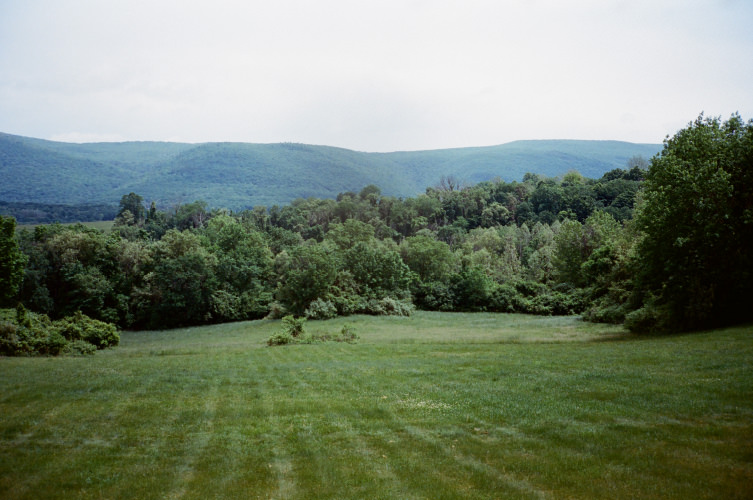
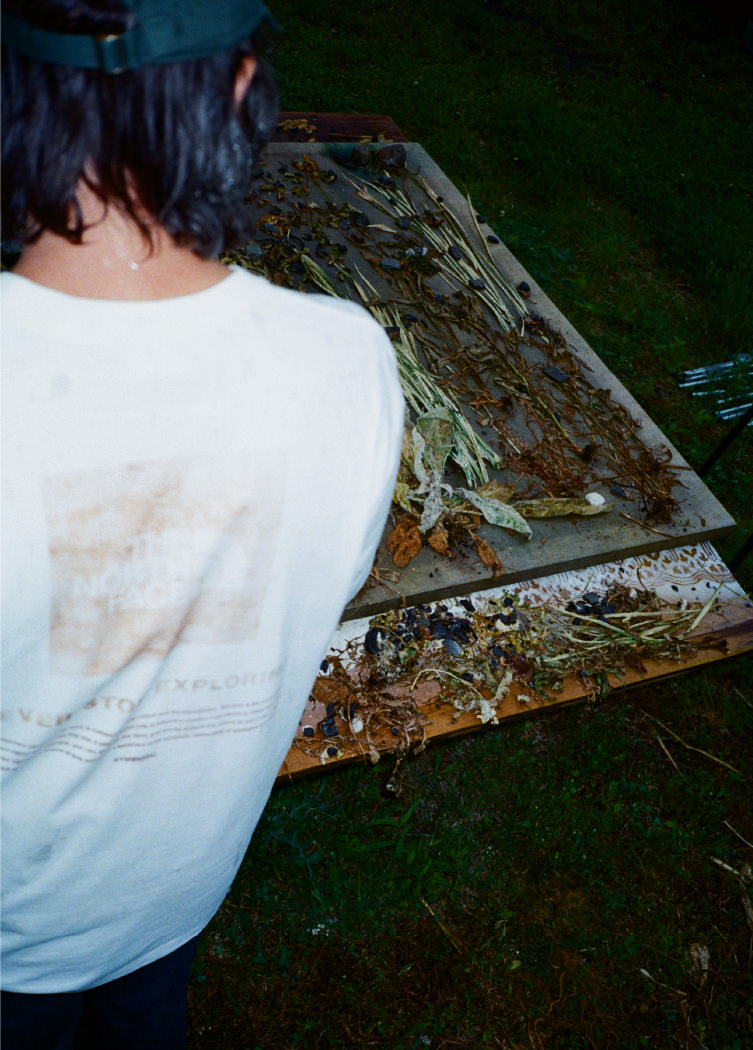
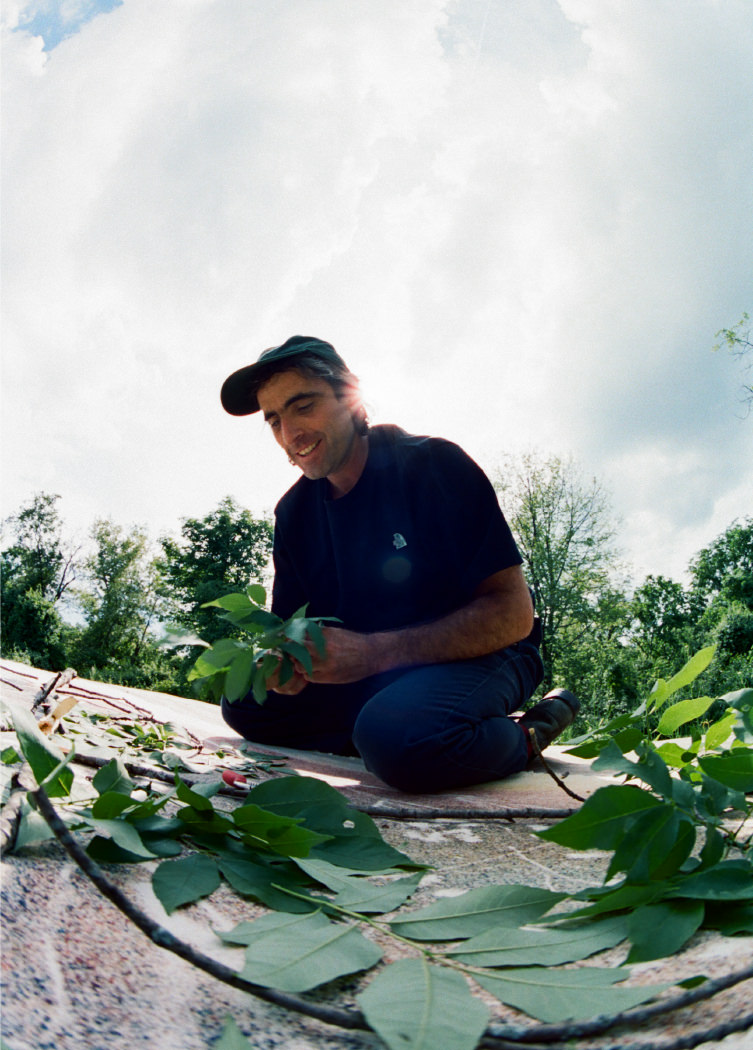
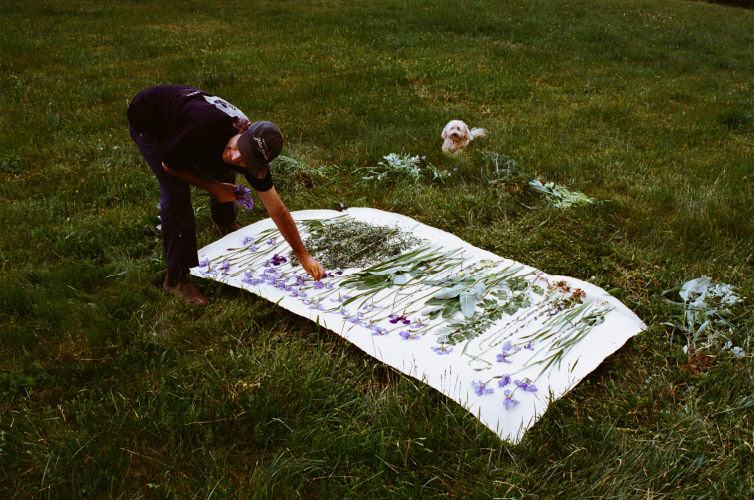
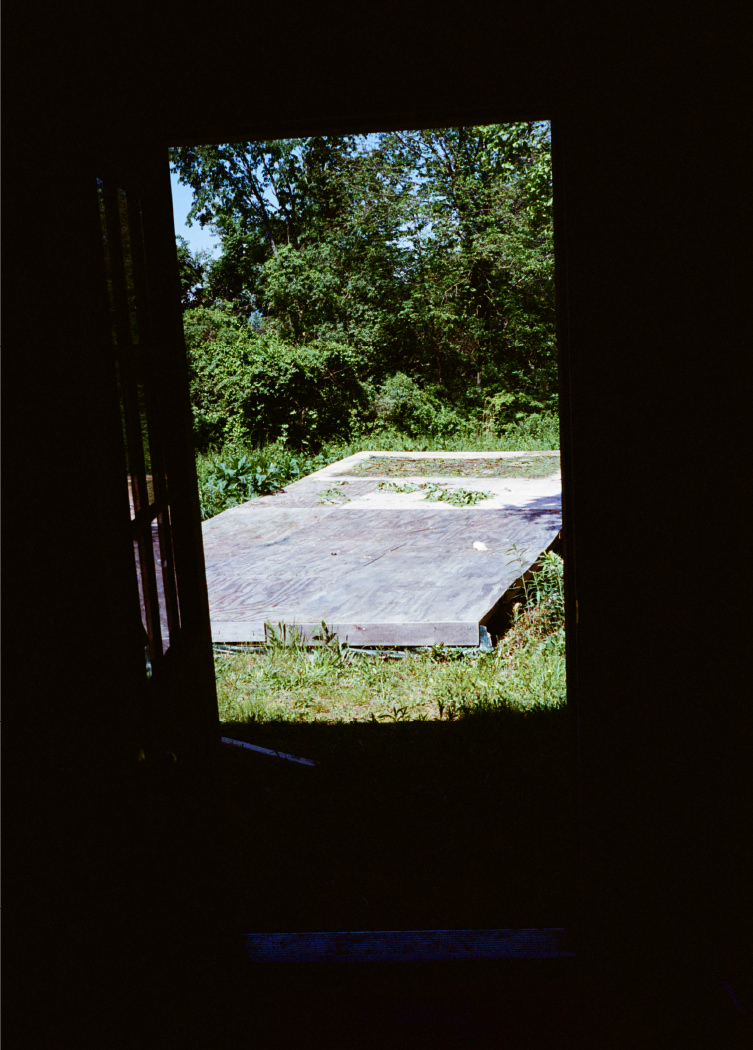
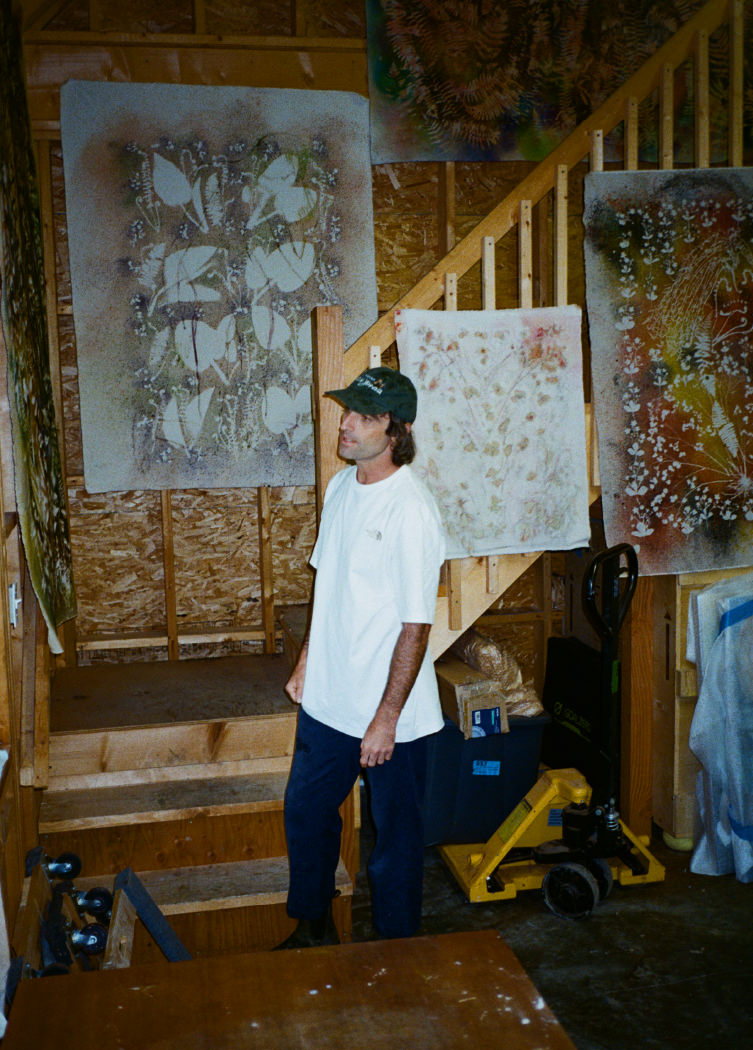
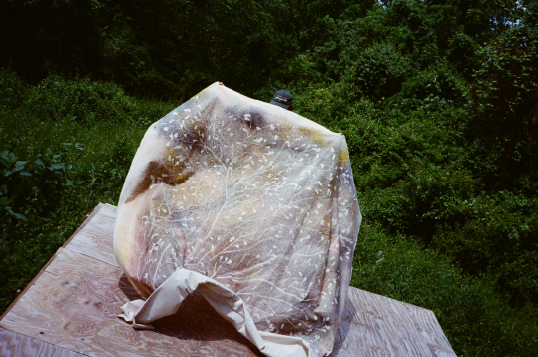
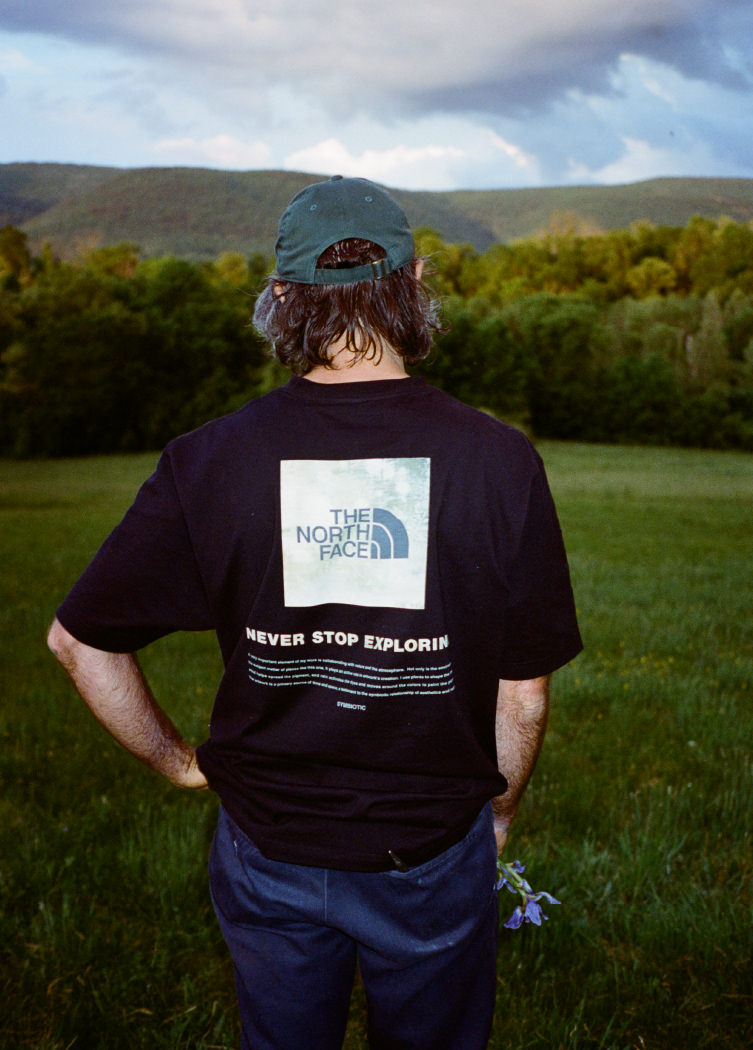
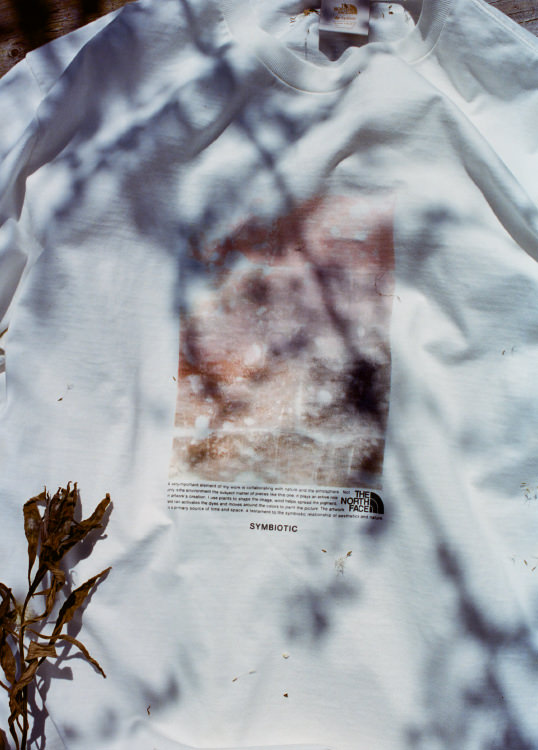
About the Collaboration
Interview with SAM FALLS
簡単な自己紹介をお願いします。
Can you introduce yourself?
Sam
サム・フォールズ、ニューヨークとロサンゼルスを拠点に活動しているアーティストです。物理学、哲学、言語学、美術史を学び、写真を経て、今に至ります。現在はキャンバス、写真、陶器、彫刻など、さまざまな媒体を用いてコンセプチュアルな作品を制作しています。
My name is Sam Falls, and I am an artist based in New York and Los Angeles. I studied physics, philosophy, semiotics, art history, and photography. I specialize in making conceptual works on canvas, linen, photography, ceramics, and sculpture.
どのようにして現在のキャンバス作品の制作手法にたどり着きましたか?
Please tell us about your artwork process using canvas. How did you arrive at your current style?
Sam
大学で美術史を学んでいたとき、作品と鑑賞者との間の溝を埋めることに関心を持ち始めました。というのも、その頃のモダンアートやコンテンポラリーアートでは、鑑賞者やアート作品よりもアーティストに焦点が当てられているように感じていたのです。大学院では写真を専攻しましたが、写真だけを使ってアート作品を作るというのは私の行きたい方向とは少しずれていることに気づきました。どんな写真を撮ろうと、カメラレンズのフィルターを通り、紙にプリントされて額に飾られると、それは作品が生まれた場所と時間から切り離されたものではないかと。そこから、フィルムやデジタルカメラなど機械的なものは取り除き、写真の原理原則である「時間」と「光」を使った表現方法を探し始めました。こうして必然的に屋外で制作するようになったのです。
初期は、布を地面の上に放置し、その上にものを置いて、1、2年かけて太陽の光で色褪せさせる大規模な自然のフォトグラムを作っていました。それが現在の手法に辿り着くための大きな一歩でしたね。そのマテリアルは、鑑賞者が時間や空間を「体験」できる第一の情報源でしたから。この作品を制作すべく、ニューヨークからより日光の強いロサンゼルスに移住しました。ですが、冬場の突然の豪雨のとき、それに対処する他の方法を考えなければなりませんでした。それに、当時は抽象写真や多くのニューメディアの流れもあって、絵画を模範とするようなやり方を見つけようとしていました。そこで、プリントの工程や絵筆を使って描くように、雨で作用する染色顔料を使い始め、雨や大気中の水分で作品を完成させるという今の手法が生まれました。
When I was in college, my interest mainly focused on bridging the gap between artworks and viewers over time. From modern to contemporary art, the mediums began to increasingly revolve around artists instead of viewers and the artwork itself. I was undertaking photography in graduate school at the time, but I felt that using only photographs to create artwork slightly differed from the direction I wanted to take. Regardless of the image, it undergoes various filters of a camera lens and then gets printed on paper and framed. In other words, the image is detached from the moment of its creation in the place and the time it was made. So, I discontinued the use of mechanical mediums, such as film and digital cameras, and began using the philosophical precepts of photography: time and light. Both brought me outdoors.
I was making essentially large-scale natural photograms, which involves leaving fabric outdoors with an object on it that would fade under sunlight over one or two years. I found that it was a successful first step to where I am now because this material has become a primary source of information for viewers and enabled them to experience time and space. I moved to Los Angeles because the sunlight I needed was much more available than in New York. However, during sudden downpours in the winter, I began considering other ways to access that. In addition, abstract photography and various new media processes were emerging at the time. This prompted me to figure out a process for basically mimicking painting. I started working with pigments in the rain as an activating tool, which is similar to the printing process or painting using a paintbrush. Rain and moisture in the air became catalysts of the finished work.
作品作りはどのような場所で、どのようにスタートするのですか?
Where and how do you start a creation?
Sam
太陽と雨を用いるので、制作時間の約90%は外で過ごしています。国立公園や国有林に行くときは、興味のある自生植物や場所を探します。新しい土地ではいつも、その場所に同調するため多くの時間を費やすのです。もしくは、より個人的に重要なエリアであるハドソンバレーの自宅周辺で制作しています。ここではより長期間にわたって制作ができるので、新しく咲いた花を観察し、季節の移ろいを見ることができます。通常、植物が陽差しで萎れるのを避けるために夕方から作業し始め、雨や湿気が生じて染色顔料が作用する夜遅くまで取り組んでいます。
Working with the sun and rain, I spend 90% of my time outdoors. I travel to national parks and forests to find native plants and places that I am interested in. If I go to a new place, I spend a considerable amount of time getting in tune with the area. Alternatively, I work in the Hudson Valley around my house, a more personally significant area. I search for newly blooming plants that describe the season, as I can work longer here. I begin the process of making rain paintings in the evening to prevent the plants from wilting under the sun and then work on them deep into the night as rain and moisture arrive and activate the dyes.



今回、ザ・ノース・フェイスとのコラボレーションに選んだ作品「Spring Snow」(2023)の制作背景について教えていただけますか?
Can you tell me about the background of the artwork Spring Snow (2023), which we chose for our collaboration? How was it created?
Sam
ハドソンバレーにスタジオを構えてから、作品は一段と進化してきました。キャンバスを外に長時間置いておくと、花瓶に生けられた花のように、植物がキャンバスに染み込んだ水分を吸い上げていることが分かりました。その状態で植物はより長く生き生きと保たれ、雨や光にしばらくさらされた後に植物を取り除くと、このような幽玄なプリントを残すのです。春にこの作品に取り掛かり、その時季に最初に咲いた花を置き、夏から秋にかけてレイヤーを重ね、季節によって異なる天候を反映させました。この絵は、軽やかな色彩を放っており、季節が巡り、植物が咲き入れ替わりながら霧や雨、少量の雪に何度もさらされたことを表しています。
One part of the work was developed after we obtained this studio space in Hudson Valley. Leaving the plants outside longer, I realized that they were also absorbing the water that was saturated on the canvas, similar to flowers in a vase. In the state, they stayed alive longer, which enhanced the image by leaving a unique ghostly print when I removed them after they had been exposed to rain and light for a while. This artwork began in the spring which let me work with the first plants that bloomed. I worked over the summer and into the fall; I replaced layers and let the painting depict different weathers and seasons. So, the painting exudes the lightness of the color and reflects how the work was exposed to fog, rain, and small amounts of snow, as the seasons passed and the plants bloomed and replaced.
この名前は三島由紀夫の本のタイトル『春の雪』 (1965-1967) と重なります。本との関連性、そしてどのようにしてこの題名を選んだのかお伺いしたいです。
The name coincides with the title of Yukio Mishima’s book. How is the book related to the artwork and how did you select this title for your artwork?
Sam
その夏はほとんど三島由紀夫のオーディオブックを聴いていました。「Sprig Snow」と名前をつけたのは制作が完成してからで、春の降雪を使用したという技法的な点と、時間の過ぎゆく感覚を描いた本という二つの要素から、ぴったりだと思ったからです。加えて、私の作品における重要な要素は「メランコリー」であり、私の作品を最もよく表す言葉でしょう。それは悲しみでもダークなものでもありません。というよりも、時の経過を受け入れ、希望を感じる情緒的な表現で、いつも作品の中で取り扱いたいと思っていました。そこで、身体が太陽にさらされ、人生の経過とともに朽ちていくように、この作品を露光させました。成長と衰退、それらの組み合わせが根底にあるのです。
自然を扱うことは、もともと意図していたことではありませんでしたが、創作を続ければ続けるほど、自然との結びつきが深まり、自然をただ楽しむだけではなく、環境保護を意識するようになりました。子供を持つことや、子供の成長を眺めるほろ苦い気持ちなど、人生における多くのことにも通じます。私はその感覚と喜びを捉えたいのです。三島の『春の雪』におけるラブストーリーには、そのような心情が描かれていると思います。春の雪というのは、その季節の最後の雪であり、すぐに溶け、いつまでも残ることはありません。美しくも儚い。この本のタイトルにある二つの単語には多くのことが凝縮されています。
That summer, I mainly listened to audiobooks from the Yukio Mishima catalog. After finishing the piece, I named it Spring Snow which was perfect because it reflected both the technical aspect of working with precipitation in spring and the fact that the book also addresses the sense of time passing. In addition, I think an important element in my work is “melancholy,” which I think is the best word to describe it. It does not mean total sadness or darkness; instead, I find a hopefulness in this emotional content that deals with the passing of time. It is a state that I always wanted to address through my work. I intended my work to be a durational exposure and a depiction of the way our bodies are exposed to the sun and decay over the course of our lives. Growth and decay. For me, this combination is the heart of the matter.
It was not always my original intention to work with nature, but the more I did it, the more I bonded with nature and became not only a person who enjoys it but also an environmentalist. I think this process mimics many aspects of human life, from having children to the bittersweet feeling of watching them grow up. I am trying to capture this emotion as well as my excitement for them. I think the love story in Mishima’s Spring Snow (1965–1967) tries to describe this feeling. Spring snow is the last snow of the season, and it melts and dissipates quickly. It is beautiful but fleeting. The two words in the book title describe so much.
そもそもなぜ日本の文学に興味を持つようになったのですか?
Why is Japanese literature interesting to you?
Sam
もともとは松尾芭蕉の俳句、放浪者であり旅人である彼の人生に対するアプローチを通じて、日本の哲学や仏教に興味を持つようになりました。学生時代は、アメリカの詩、なかでも日本に長く滞在したことがあるサンフランシスコ出身のビート詩人、ゲーリー・スナイダーについて学び、そこから芭蕉を知りました。オレゴンのリード大学に行ったのは、スナイダーがかつて通っていたということに加えて、原子炉があったからでした。その経験は、科学と詩の融合のようなもので、対照的な二人である芭蕉と三島を想起させます。三島は政治や社会とのつながりを持っていたのに対し、芭蕉はそれらから逃れようとしていて、彼らは正反対の存在です。けれど、この2つの視点の間には、ある特別な文化を見出すことができます。科学と詩に対する私の考え方も同じで、そこに日本との結びつきを感じました。
I originally became interested in Japanese philosophy and Buddhism through the haikus of the poet Matsuo Bashō and his approach to life as a wanderer and traveler. At the same time, I was studying American poetry, specifically Gary Snyder, a beat poet from San Francisco who spent a long time in Japan, which is how I discovered Bashō. I went to Reed College in Oregon for undergraduate studies, because Snyder went there, and it has a nuclear reactor. So, this experience was a combination of science and poetry, which always reminded me of my views of Bashō and Mishima, who were relatively different. Mishima had connections in politics and society, while Bashō was essentially the opposite by escaping such connections. However, I see a particular culture in the middle of these dual perspectives. The same is true for my views about science and poetry, and I felt a nice corollary connection to Japan.
あなたの作品は人などのモチーフが植物やオブジェを使って描かれることもありますが、「Spring Snow」ではいかがですか?
Your works sometimes have motifs such as people using plants and objects. Is there any specific motif in Spring Snow?
Sam
この作品にモチーフはありません。たいていは、作品を作る場所の周囲の植物によって作品の大きさが決まります。森では高い木々が生えているので、その枝を使った大きな絵を制作することもあります。この作品では、いくつかの季節をまたいで制作することをあらかじめ想定していたので、小さなものを見失わず季節を捉えられるように十分な大きさにしたかったのです。こうした考えから、サイズとそれに合うような植物や花を選びました。
There is none in Spring Snow. Typically, the plants around the place I work dictate the size of the artwork. Forests have tall trees, so I can make bigger paintings using the branches. For this work, it was really this idea of knowing I would be working with it through a few seasons. So I wanted the size to be large enough to capture them without losing perspective of small objects. These ideas led me to decide on the size of the canvas as well as the plants and flowers that will be used, which seemingly fit well.
この作品は、薄い緑から暗い茶色まで、色に幅があるのが特徴的です。色に関してはどのように決めましたか?
This work shows a wide range of colors, from light green to dark brown. How did you decide on the colors?
Sam
色彩は私の作品において大切な要素です。特殊な染色顔料を使うことで、現在の手法に発展しましたからね。ひとつの作品でレイヤーごとに数色ずつ選びますが、最終的にはほとんどの作品に全色使います。屋外に置いておくと、水が染色顔料に触れてさまざまな動きを描き出します。そのときの大気に左右されるのです。雨がたくさん降ればより明るくパステル調になりますし、そうでなければ重たい色彩になる。単色で統一すると水の流れや花の配置などの表現が失われてしまうので、レイヤーの間に色のコントラストを持たせているのです。この絵の最初のレイヤーは春を捉えています。ハドソンバレーが緑葉であふれ、紫やピンクのアヤメ、赤いケシが混じっていたので、大量の緑を使いながら、それらの花の色を少量含めるようにしました。夏は暑さで植物が熟すため、よりコーラルや暖色系の色にシフト。秋になると朽ちていくので、黒や茶色を多用しました。
Color is an interesting aspect in my work because my work has evolved to a point where this specific pigment is used. For nearly every painting, I choose several colors for each layer and eventually use all colors. The reason is that water depicts so much movement to which the pigments are exposed if I leave it outside. It depends on the atmosphere of the moment. If there is heavy rain, then the color will be lighter and more pastel; if not, then the color will be heavier. It is about ensuring contrast between all colors, because if I was just using one color, it would lose a lot of the information about where the water was and how the flowers were placed. The first layer of this painting depicts springtime. The outdoors in Hudson Valley were green with splashes of the colors of flowers such as purple and pink irises and red poppies. I used smaller amounts but included these colors and large amounts of green. In the summer, as the weather became hotter and the plants matured, I shifted to using coral colors and warmer tones. In the fall, I used more black and brown hues, as the plants decayed.



サーフィンやバックカントリーのスノーボードなどが趣味だそうですね。アウトドアスポーツは、ライフスタイルや制作にどのように影響を与えていますか?
I heard that surfing and backcountry snowboarding are your hobbies. How do you think outdoor sports influence your lifestyle or your work?
Sam
野外とのつながりに大きな影響を与えています。アウトドアスポーツは私の人生の一部であり、それがあるから自然の中で過ごす時間を多く持てています。アートとは違えど、いつも自然のことを考えています。こうして家の中にいる今でも、外に出て、自然の中にいたいと思っているくらいです。とりわけサーフィンとスノーボードは、子供の頃から続けているスポーツ。作品づくりとは違う形で自然とコラボレーションができるとても美しい方法なのです。サーフィンをするときは、海のコンディションや波の形状を考えなければなりませんが、この天候に対する関心と関わりが私のアート作品の一部となりました。最近よくしているスプリットボードでも、雪の模様を見るのが好きです。登りはスローモーションで、そして下りは急加速する山での静かな体験に魅了されます。パドリングをして海に潜り、座って待っているのと同様に、どちらもとても瞑想的で、作品作りと似ています。その場所をよく観察し、自分の進むべき方向を把握する。時間をかけて進めていくことで、いい作品が生まれるのです。
They have influenced my connection to the outdoors. Playing outdoor sports is another component of my life that allows me to spend most of my time in nature. It is different from art, but I am always thinking about nature. Even now, as I am inside my house, I want to go outside and be with nature. Specifically, surfing and snowboarding are the major sports that I have been engaged in since childhood. It is a beautiful way to collaborate with nature in a different way. In surfing, I need to consider the condition of the ocean and the shape of the waves. This interest in and relationship with weather has become part of my artwork. Also, with splitboarding, which I have been doing a lot lately, I have become fixated on seeing snow patterns. The quiet experience of the mountain that is in slow motion on the way up then accelerates on the way down is beautiful. The same is true for paddling, as one goes under water, sitting and waiting. It is all very meditative, which is the same as my art process: I examine the area and it tells me the direction I should take. The process slows down for the work itself.
ザ・ノース・フェイスにまつわるパーソナルな思い出があれば教えてください。
If you have any of your personal memories of The North Face, can you share it with us?
Sam
幼少期はバーモント州で育ち、スノーボードを始める前はスキーが趣味でした。10歳の頃、友人の父親が北東部で最も高い山、カタディンへハイキングに連れて行ってくれたとき初めて、ザ・ノース・フェイスの素晴らしいアウトドアウェアを手に入れました。ダークブルーのシンプルなレインシェルに白いロゴが入り、防水性能を備えた一着でした。それを着てスキーやスノーボードをするたびに、クールだと感じていましたね。その体験は、服と機能性との関係について認識するきっかけにもなりました。現在、持っているギアの多くはザ・ノース・フェイスのものです。
I grew up in Vermont, and I was a big skier. My friend’s dad took us to hike Katahdin, the tallest mountain in the Northeast, which was the first time I bought a nice piece of outdoor clothing from The North Face. It was a simple rain shell in dark blue with a white logo and a waterproof performance layer. I always thought it was so cool in between spending much time outdoors skiing and snowboarding. This experience made me realize the relationship between clothing and function. Currently, a lot of my gear is from The North Face.
「探求をやめない」は、ザ・ノース・フェイスのスローガンですが、「探求」と聞いて何を思い浮かべますか?
“Never stop exploring” is the slogan at the heart of The North Face. What comes to mind when you hear the word “exploring”?
Sam
このスローガンは、人生のあるべき形を表しています。私は少しノマド的で、今でも西海岸と東海岸を行き来しています。もう15回は車で横断しました。こうした旅の一番いいところは、境界的なスペースと社会の外にいる時間を過ごせること。自然の中を散策したり、新しい街を歩いたりすることは、精神発達にとても大切です。子供たちにも新しいものを見せたいのです。新しい木の種類を知り、花が芽吹いているのを見るだけでも、とてもエキサイティングな冒険ですから。
The slogan is perfect for how life should be. I have always been slightly nomadic. Even now, I go back and forth between the West and East coasts. I have driven across the country 15 times. For me, the best part of these journeys is the intermediary spaces and time outside of society. Being on the road in nature or even walking in a new city is crucial for mental development. Right now, all I want to do with my kids is introduce them to new things because even just learning about a new type of tree and witnessing the sprouting of flowers are exciting adventures.
ザ・ノース・フェイスとスパイバー、ご自身とのコラボレーションの話があったとき、どのように感じましたか?
What was your first thought when you heard about this collaboration, you and The North Face and Spiber?
Sam
とてもうれしかったです。コラボレーションの依頼はあっても、アートから外れていると感じたり、商業的すぎると感じたりして、引き受けないことがほとんどですからね。けれど、今回のコラボレーションは、私が敬愛し、長年親しんできたザ・ノース・フェイスとのコラボレーションというだけでなく、スパイバーが持続可能性と地球環境に焦点を当てている点でも、とても興味を惹かれるものでした。
It was exciting to be part of a collaboration, which I do not typically undertake because it is often outside of art or feels very commercial. The thing that caught my eye was the fact that this collaboration was not only with The North Face, for which I hold personal admiration and long experience, but also Spiber, which is focused on sustainability and the environment.



クモや羊のような循環型タンパク質繊維を作り、それを環境に有害な素材に代わって衣服に使うというスパイバーのブリュードプロテイン™︎のアプローチについてどのようにお考えですか?
What do you say about the approach of Spiber’s Brewed Protein™︎ creating circular protein fibers such as spiders or sheep and using them to replace environmentally harmful materials in clothing?
Sam
持続可能性であるということだけでなく、新しい製品を開発するために用いられた技術と科学に感銘を受けました。ここから将来性のある他の製品が生まれていくという展望に、期待を掻き立てられます。地球への負荷を減らすと同時に、リユースやリサイクルを超えた別の道を切り拓いていくでしょう。
私は、自然界にすでにあるもの以上に美しいものや優れた構造を人間は作り出せないと考えてきました。スパイバーが目指すべきものとして動植物の科学、つまり環境にあらかじめ存在する構造を取り入れているのは、「必要なものはすべてすでに自然にあり、完璧である」という原則に従っているように思います。このプロジェクトに選んだ「Symbiotic(共生)」という言葉のように、自然、科学、技術との思慮深いコラボレーションですね。スパイバーは、自然にダメージを与えない方法のみならず、自然と手を取り合い、自然の力を借りてものを生み出していく方法を見出しています。
I was impressed with the technology and science applied to the development of products that are not only sustainable but also new. The prospect that other potential items could be produced as a result of this technology is thrilling because it could be a strategy for lowering our impact on earth as well as for creating a path that goes beyond simply reuse or recycle.
Early on, I have accepted that humans will never be able to make products more beautiful or better constructed than those in nature. The way that Spiber uses science in plants and animals as its guide and preexisting structures in the environment follows the principle that everything humans need has been existing and is perfect. Similar to the word that we chose for the project, “symbiotic,” it is a mindful collaboration between nature, science, and technology. Instead of finding ways to avoid inflicting damage to nature, Spiber is finding ways on how we can work with and through nature.
コラボレーションのデザインをする過程で、1つのアートピースを複数の製品にさまざまな方法で使用するという提案が興味深かったです。どのようにしてそのアイデアを思いついたのですか?また、完成したプロダクトで気に入っている点を教えてください。
In the design process of a collaboration between you and The North Face, we saw your interesting approach of using one art piece for multiple products in different ways. How did you come up with the idea? Also, please share what you like about the finished products.
Sam
さまざまな要素、色、そして季節を横断しているため、絵を部分的に切り取ってさまざまな製品に配し、コラボレーションとしてまとめると全体の作品になるという考えが浮かびました。また、私が書いた概要テキストをプリントするのは、ザ・ノース・フェイスのアイデアでしたね。書いたときはメディア向けに使ってもらえればと思っていましたが、作品と一緒に前面に出し、その素材と持続可能性の理念について考慮されていることがうれしかったです。通常は作品の裏に隠れているものなので、私にとって新鮮でした。単に作品というより、このコラボレーションの包括的なテーマが重要だったのです。
The work features various elements and colors that traverse seasons, so we could take sections of the painting and cut them to be distributed across products. It was your idea to print the text of my synopsis. When I wrote it, I hoped it would be used more for the press, but I was extremely happy to have it foregrounded with the work and to have this consideration for the philosophy, which are both materials that we are addressing and sustainability. It was refreshing for me because it is often backgrounded. Apart from the painting, the overarching theme of this collaboration was important.
「共生」という言葉は、よく作品について使う言葉ですね。あなたにとってのこの言葉の意味を教えていただけますか?
“Symbiotic” is a word used in the project, which you often use to describe your work. Can you tell us what the word means to you?
Sam
これまで長年、自然との共同作業における私のプロセスを表現するためにこの言葉を使ってきました。2つの有機体は協力し合うことで共存し、片方なしに存在することはできません。自然は私の芸術を創造するのに必要なものであり、また私の芸術が人々に自然の美しさだけでなく、その裏にある、私が自然保護に対して抱いている深い理念的な考えも喚起するものとなることを願っています。鑑賞者を自然に導き、そしてまた自然を屋内に取り込み、両者の間に生まれる共生的な空間を作れたらうれしいですね。
I have used the term many times over the years to describe my process of collaborating with nature. My understanding of it is that two organisms sustain each other through collaboration, such that one cannot exist without the other. Nature truly feeds what I do and is necessary to make art, and the art that I make hopefully creates not only awareness about the beauty of nature but also the deeper conceptual agenda I hold in relation to its preservation that is not commonly found on the front line of the work. I want to bring viewers outdoors and the outdoors inside and to create a symbiotic space between the two.
人間と地球の未来について、どのようにお考えですか?環境を改善する方法についてお考えがあればお聞かせください。
What are your predictions about the future in terms of humans and the earth? Any thoughts on how to improve the environment?
Sam
希望に満ちた率直な方法が考えられます。最近、リチャード・パワーズの『オーバーストーリー』(2018)という本を読み終えたばかりなのですが、その中に登場する生物科学者は講義の中で「人類にとって最も環境に配慮できることは消滅すること」と説いています。一方で、もうひとつの方法について「草を刈らずに庭を自然界すべての住処にすることで、2年以内に1,000%以上の生物種が増える」と唱えています。土地を自然界に戻し、都市開発を止めることは、環境面だけでなく、文化的、社会的にも素晴らしいことでしょう。子供が生まれたことが都市を離れて創作をするきっかけになったかは分かりませんが、情報技術は不安を煽るものになっていて、スクリーンの中や室内に閉じこもる人が増えているように感じます。人々が自然にもう一度向き合い、自然の中に回帰していくことを願っています。
I can think of hopeful and honest ways. I just read the book The Overstory (2018) by Richard Powers, which features a biological scientist. In a lecture, the scientist explains that the most environmentally friendly actions that humans can truly do would be to disappear. But, another way is to let your yards be home to all of the natural things by not mowing lawns. Within two years of not mowing lawns, 1,000% more species will thrive. I think that this idea of rewilding spaces and deurbanization would be beneficial not only to the environment but also to culture and society. I am unsure whether having kids is comparable to working away from the city, but I feel that information technology has only become disturbing and more people are locked into screens and indoors. I hope people fall in love with nature again and return to a type of rewilding process.

Spring Snow, 2023

SAM FALLS
サム・フォールズ(1984年生まれ)は、アメリカのバーモント州で育ち、現在はニューヨークとロサンゼルスを拠点に制作活動を行っている。リード大学で物理学、言語学、哲学を学び、2007年に学士号を取得後、2010年にICPバード芸術研究課程を修了した。
サム・フォールズの最近の個展には、フリーダー・ブルダ美術館「Waldeinsamkeit」(ドイツ、バーデンバーデン、2024年)、クリーブランド現代美術館「We Are Dust and Shadow」(アメリカ、オハイオ州、2023年)、トレント・ロヴェレート近現代美術館「Nature is the New Minimalism」(イタリア、2018年)、アーマンド・ハマー美術館(アメリカ、ロサンゼルス、2018年)、ザ・キッチン(アメリカ、ニューヨーク、2015年)、ボールルーム・マーファ(アメリカ、テキサス州、2015年)などがある。2018年には第21回シドニービエンナーレにも参加している。
Sam Falls (born in 1984) was raised in Vermont and lives and works in New York and Los Angeles. He studied physics, linguistics, and philosophy at Reed College, receiving his BA in 2007 and his MFA from ICP-Bard in 2010.
Recent solo museum exhibitions by Sam Falls include Waldeinsamkeit, Museum Frieder Burda, Baden-Baden, Germany (2024); We Are Dust and Shadow, MoCa, Cleveland, Ohio (2023); Nature is the New Minimalism, Museum of Modern and Contemporary Art Trento and Rovereto, Italy (2018); Hammer Museum, Los Angeles, CA, US (2018); The Kitchen, New York (2015); and Ballroom Marfa, Texas (2015); as well as his participation in the 21st Biennale of Sydney.
Photography: Peter Sutherland
Interview: Maki Saijo






